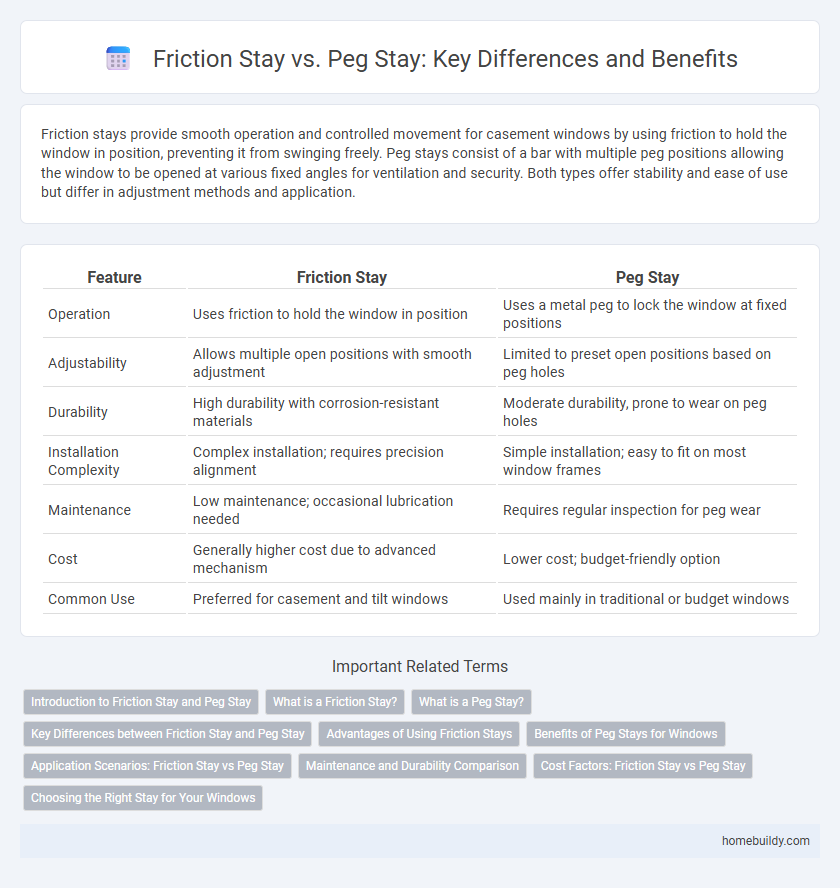Friction stays provide smooth operation and controlled movement for casement windows by using friction to hold the window in position, preventing it from swinging freely. Peg stays consist of a bar with multiple peg positions allowing the window to be opened at various fixed angles for ventilation and security. Both types offer stability and ease of use but differ in adjustment methods and application.
Table of Comparison
| Feature | Friction Stay | Peg Stay |
|---|---|---|
| Operation | Uses friction to hold the window in position | Uses a metal peg to lock the window at fixed positions |
| Adjustability | Allows multiple open positions with smooth adjustment | Limited to preset open positions based on peg holes |
| Durability | High durability with corrosion-resistant materials | Moderate durability, prone to wear on peg holes |
| Installation Complexity | Complex installation; requires precision alignment | Simple installation; easy to fit on most window frames |
| Maintenance | Low maintenance; occasional lubrication needed | Requires regular inspection for peg wear |
| Cost | Generally higher cost due to advanced mechanism | Lower cost; budget-friendly option |
| Common Use | Preferred for casement and tilt windows | Used mainly in traditional or budget windows |
Introduction to Friction Stay and Peg Stay
Friction stay and peg stay are two common types of window stays used to control window opening angles and ensure secure positioning. Friction stays rely on metal arms with a friction mechanism to hold windows open at various angles, offering smooth operation and adjustable ventilation. Peg stays use notched metal strips and pegs that fit into these notches, providing fixed opening positions with a simple, durable design ideal for traditional casement windows.
What is a Friction Stay?
A friction stay is a type of window hinge that allows the sash to hold its position at various angles without additional support, using built-in friction mechanisms. It is commonly used in casement and awning windows to provide controlled ventilation while maintaining stability. Compared to peg stays, friction stays offer smoother operation and enhanced durability, making them suitable for modern window designs.
What is a Peg Stay?
A peg stay is a simple window stay mechanism that secures the window sash in fixed open positions using a metal peg inserted into pre-drilled holes along the stay. Unlike friction stays, which use friction to hold the window open at various angles, peg stays provide firm, unmovable stops for safety and ventilation control. Commonly used in casement windows, peg stays offer reliable durability and ease of maintenance.
Key Differences between Friction Stay and Peg Stay
Friction stays use a friction mechanism to hold windows in desired positions, offering smooth operation and adjustable ventilation, while peg stays employ fixed pegs to lock windows at specific open points but with limited adjustability. Friction stays are commonly made from stainless steel for durability and corrosion resistance, whereas peg stays are often simpler in design and less robust under heavy use. The key difference lies in the flexibility of window positioning, with friction stays providing continuous adjustment and peg stays offering discrete, fixed positions.
Advantages of Using Friction Stays
Friction stays offer superior durability and smooth operation, ensuring consistent window movement without the risk of loosening over time. Their robust design provides enhanced security by maintaining a firm hold on the window sash, reducing the likelihood of accidental openings or break-ins. Unlike peg stays, friction stays support larger and heavier windows with greater stability and precision.
Benefits of Peg Stays for Windows
Peg stays offer enhanced security for windows due to their robust locking mechanism, which prevents unauthorized opening from outside. They provide smooth and reliable operation with minimal maintenance, ensuring long-lasting performance compared to friction stays that may wear out over time. Peg stays also allow precise control over window opening angles, improving ventilation while maintaining safety and stability.
Application Scenarios: Friction Stay vs Peg Stay
Friction stays are commonly used in casement windows requiring smooth, adjustable opening and controlled ventilation, ideal for modern residential and commercial buildings. Peg stays are better suited for traditional sash windows or situations where a simple, cost-effective hinge mechanism is needed, often found in older or heritage properties. Choosing between friction stays and peg stays depends on the window type, desired functionality, and architectural requirements.
Maintenance and Durability Comparison
Friction stays offer superior durability with robust metal construction and corrosion-resistant finishes, requiring minimal maintenance such as periodic lubrication to ensure smooth operation. Peg stays, while simpler in design and easy to replace, are more prone to wear and corrosion over time, necessitating more frequent inspections and upkeep to maintain functionality. Overall, friction stays provide longer-lasting performance and reduced maintenance demands in window applications.
Cost Factors: Friction Stay vs Peg Stay
Friction stays generally have a higher upfront cost compared to peg stays due to their complex design and integrated friction mechanism, which provides smoother operation and better load distribution. Peg stays are more cost-effective initially but may incur higher maintenance expenses over time because of their simpler construction and susceptibility to wear and tear. Choosing between friction and peg stays often depends on balancing initial investment against long-term durability and operational efficiency.
Choosing the Right Stay for Your Windows
Friction stays offer smooth, adjustable opening angles and enhanced security, making them ideal for modern aluminum and uPVC windows. Peg stays are simpler, cost-effective options suited for traditional wooden casement windows with limited opening control. Selecting the right window stay depends on the window material, desired ventilation control, and security needs to optimize functionality and durability.
Friction stay vs Peg stay Infographic

 homebuildy.com
homebuildy.com